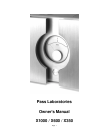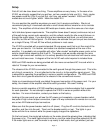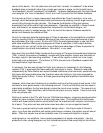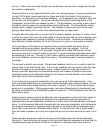Page 7
and the energy reserve held in the capacitors will do its job. As a practical matter, it will not
make a lot of difference. Just don’t call us up and complain that you only measured 1900
watts in your living room. If you do, we’ll want to know what speakers can take it.
Interconnects and Speaker Cables
We have a general recommendation about interconnects, which is that they should cost less
than the amplifier. We have tried a lot of products and most of them work well, but as a
practical matter we cannot make blanket recommendations.
The amplifier is not sensitive to source interconnects. It is also not sensitive to radio frequency
pickup, which allows some flexibility in choosing source interconnects without shields.
We prefer speaker cables that are thick and short. Silver and copper are the preferred metals.
If you find any cable made of gold, please send me a couple hundred feet.
Fortunately the amplifier is not sensitive to the capacitive/inductive character of some of the
specialty speaker cables, so feel free to experiment.
We have found that about 90 per cent of bad sounding cables are really bad connections, and
we recommend that special attention be paid to cleanliness of contact surfaces and tight fit.
Speaker cables should be firmly tightened down at the speaker output terminals, but do not
use a wrench. They will not withstand 100 foot-lbs of torque. Hand tightening without
excessive force is plenty.
Source Interaction
The amplifier does not care what the source impedance is, although its gain will drop a bit with
high source impedances. Since we have 30 dB of gain (26 dB in the X350), we can afford to
throw a little bit away, since the quality is unaffected. Using a balanced source attenuated
through a balanced passive attenuator is perfectly OK, and we often use this approach
ourselves to minimize components in the signal path and also to reduce bit loss in CD players
with digital volume controls.
The differential input impedance of the amplifier is 22000 ohms, although this drops to 2000
ohms when the amplifier is in stand-by mode. 22000 ohms is not a problem for any balanced
source circuit we ever heard of, and will not be a problem for you.
As pointed out elsewhere, this power amplifier is the first ever to truly take advantage of the
concept of balanced operation for more than just noise reduction. As such it prefers balanced
input symmetry for optimal operation.


















